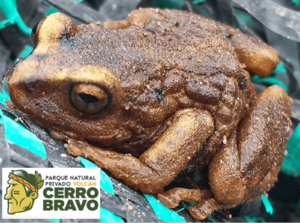Niceforonia facts for kids
Quick facts for kids Niceforonia |
|
|---|---|
 |
|
| Niceforonia adenobrachia | |
| Scientific classification |
|
| Kingdom: | Animalia |
| Phylum: | Chordata |
| Class: | Amphibia |
| Order: | Anura |
| Family: | Craugastoridae |
| Genus: | Niceforonia Goin and Cochran, 1963 |
| Type species | |
| Niceforonia nana Goin and Cochran, 1963
|
|
| Diversity | |
| See text) | |
| Synonyms | |
|
|
Niceforonia is a group of frogs that live in northern South America. You can find them in places like central Peru, Ecuador, and Colombia. These frogs belong to a larger frog family called Strabomantidae. The name Niceforonia was chosen to honor Nicéforo María, a Colombian scientist who studied reptiles and amphibians (called a herpetologist).
Contents
How Scientists Classify Niceforonia Frogs
Scientists group living things into categories to understand how they are related. This is called taxonomy. The group Niceforonia is a genus, which is a smaller group within a family.
In 2008, scientists Hedges and his team brought the genus Niceforonia back into use. Before that, it was considered part of another frog group called Phrynopus. Even though there wasn't much genetic information available then, Hedges and his team thought Niceforonia was related to other frog groups like Phrynopus, Oreobates, and Lynchius.
Later, in 2014, other scientists named Padial and his team used genetic information to study these frogs more closely. They moved Niceforonia and its relatives into a different subgroup called Holoadeninae, which is part of the Strabomantidae family.
Types of Niceforonia Frogs
Here are the different types of frogs that belong to the Niceforonia genus:
- Niceforonia adenobrachia (Ardila-Robayo, Ruiz-Carranza, and Barrera-Rodriguez, 1996)
- Niceforonia aderca (Lynch, 2003)
- Niceforonia araiodactyla (Duellman and Pramuk, 1999)
- Niceforonia babax (Lynch, 1989)
- Niceforonia brunnea (Lynch, 1975)
- Niceforonia columbiana (Werner, 1899)
- Niceforonia dolops (Lynch and Duellman, 1980)
- Niceforonia elassodiscus (Lynch, 1973)
- Niceforonia fallaciosa (Duellman, 2000)
- Niceforonia latens (Lynch, 1989)
- Niceforonia lucida (Cannatella, 1984)
- Niceforonia mantipus (Boulenger, 1908)
- Niceforonia nana Goin and Cochran, 1963
- Niceforonia nigrovittata (Andersson, 1945)
- Niceforonia peraccai (Lynch, 1975)
What Niceforonia Frogs Look Like
Niceforonia frogs are quite small. They measure up to 21 millimeters (about 0.8 inches) from their snout (nose) to their vent (where waste leaves the body).
Their head is usually narrower than their body. They have a tympanic membrane, which is like an eardrum, but it might be hard to see. Sometimes, only the ring around the eardrum is visible under their skin.
The skin on their back (dorsum) can be smooth or slightly bumpy. Their belly (venter) is either smooth or has small, raised areas. The tips of their fingers and toes are not wide, but they often have faint grooves around them. The bones at the very ends of their fingers and toes (called phalanges) are narrow and shaped like a "T."
An interesting fact about these frogs is that their third and fifth toes are usually about the same length. This feature is why one of their old names was Isodactylus, which means "equal fingers."
See also
 In Spanish: Niceforonia para niños
In Spanish: Niceforonia para niños

